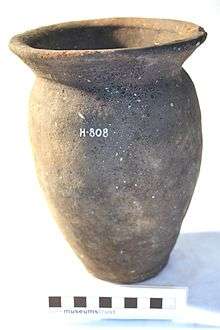Dales ware

Dales ware is a type of ceramic produced in the South Yorkshire and Lincolnshire[1] areas of England and widely distributed across northern Britain during the 3rd and 4th centuries AD.[2]
Industry
Dales ware was predominantly produced in north Lincolnshire,[3] but has other production centres in Humberside and South Yorkshire,[4] and was traded northwards, east of the Pennines in the 3rd and 4th Centuries AD. It most commonly occurs as jars.[5]
Fabric
Dales Ware
Dales ware is a handmade, shell-tempered coarseware ceramic with a distinctive rim, often wheel-formed.[5] The fabric is rough and coloured brown-grey.[5] It often includes irregular finger indentations around the lower body, but is generally smoothed towards the shoulder and over the rim and lip.[4]
Dales-type ware
The Dales-type ware was defined by Loughlin.[3] The fabric differs in being hard-fired and grey, in comparison to the above. Dales-type jars are always more numerous than true Dales ware[5] and were popular as burial urns in Roman York.[6]
See also
References
- ↑ Margaret Darling; Barbara Precious (31 January 2014). A Corpus of Roman Pottery from Lincoln. Oxbow Books. pp. 83–. ISBN 978-1-78297-054-5.
- ↑ Arnold, C. J. (1984). Roman Britain to Saxon England: An Archaeological Study. Routledge. p. 96. ISBN 0-7099-0513-0.
- 1 2 Loughlin, N. 1977. 'Dales Ware: a contribution to the study of Roman coarse pottery', in Peacock (ed.) 1977. Pottery and Early Commerce: Characterisation and trade in Roman and Later Ceramics. London, 85-146
- 1 2 "Dales ware and Dales-type ware". PotSherd. 2014. Retrieved 2015-01-23.
- 1 2 3 4 Monaghan, J. 1997.Roman Pottery from York (Archaeology of York 16/8). York: York Archaeological Trust, 897-899
- ↑ Wenham, L.P. 1968. The Romano-British Cemetery at Trentholme Drive, York (Ministry of Public Buildings and Works Archaeological Report 5). London: HMSO, figs.23-4